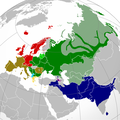Fix:Indo-European branches map.png

Grandia de esta previde: 599 × 600 pixeles Otra densias: 240 × 240 pixeles | 479 × 480 pixeles | 767 × 768 pixeles | 1,023 × 1,024 pixeles | 2,045 × 2,048 pixeles | 2,934 × 2,938 pixeles.
Fix orijinal (2,934 × 2,938 pixeles, grandia de fix: 2.16 MB, tipo MIME: image/png)
Istoria de fix
Clica un data/ora per vide la fix en sua forma de alora.
| Data/Ora | Imajeta | Mesuras | Usor | Comenta | |
|---|---|---|---|---|---|
| aora | 03:43, 26 setembre 2022 |  | 2,934 × 2,938 (2.16 MB) | Alexikoua | minor fixes |
| 15:58, 30 marto 2022 |  | 2,934 × 2,938 (1.74 MB) | Whoop whoop pull up | Whoops, wrong file! | |
| 15:37, 30 marto 2022 |  | 2,048 × 2,048 (980 KB) | Whoop whoop pull up | Misc fixes (Russian minority in Svalbard & Israel, Slovenian in SE Carinthia, Greek in N Epirus, Aromanians/Megleno-Romanians, Swedish essentially extinct in Estonia, etc. | |
| 09:37, 22 desembre 2021 |  | 2,934 × 2,938 (1.74 MB) | Ahmet Q. | Reverted to version as of 19:55, 23 August 2021 (UTC)seek consensus for your changes | |
| 20:40, 25 novembre 2021 |  | 2,934 × 2,938 (2.16 MB) | Alexikoua | rv elimination of Greek minority in Albania | |
| 19:55, 23 agosto 2021 |  | 2,934 × 2,938 (1.74 MB) | Ahmet Q. | Rv false edit summary. Overrepresentation of Greeks in Turkey, Albania and Ukraine. Unexplained removal of Romanian in Serbia. Overall deterioration of the original file. Seek consensus for your changes. | |
| 16:16, 7 agosto 2021 |  | 2,934 × 2,938 (2.16 MB) | Demetrios1993 | Addition of Arbereshe linguistic minority in Sicily. Addition of Serbian, Bosnian, and Gorani linguistic minorities in Kosovo. Addition of Greek linguistic minorities in Italy, Albania, Turkey, and Ukraine. Including some other minor corrections. | |
| 17:00, 19 novembre 2020 |  | 2,934 × 2,938 (1.74 MB) | Golden | update Armenian | |
| 18:42, 31 marto 2018 |  | 1,479 × 1,479 (574 KB) | Maphobbyist | Removed area that exactly corresponds to the non-Indo European Lezgi linguistic area. | |
| 21:37, 6 setembre 2016 |  | 1,479 × 1,479 (620 KB) | Rob984 | Georgia and Azerbaijan aren't majority multilingual. Older generations speak Russian from the Soviet era but now English is taught mainly in place of Russian. More people speak English in Finland, yet that isn't coloured. Also corrections to Celtic are... |
Usas de fix
La paje seguente lia a esta fix:
Usa global de fix
La otra vicis seguente usa esta fix:
- Usa en ast.wikipedia.org
- Usa en ban.wikipedia.org
- Usa en be-tarask.wikipedia.org
- Usa en be.wikipedia.org
- Usa en bg.wikipedia.org
- Usa en cs.wikipedia.org
- Usa en da.wikipedia.org
- Usa en de.wikipedia.org
- Usa en en.wikipedia.org
- Usa en en.wikiversity.org
- Usa en es.wikipedia.org
- Usa en et.wikipedia.org
- Usa en eu.wikipedia.org
- Usa en fa.wikipedia.org
- Usa en fi.wikipedia.org
- Usa en frr.wikipedia.org
- Usa en fr.wikipedia.org
- Usa en gl.wikipedia.org
- Usa en gu.wikipedia.org
- Usa en gv.wikipedia.org
- Usa en hak.wikipedia.org
- Usa en he.wikipedia.org
- Usa en hy.wikipedia.org
- Usa en hyw.wikipedia.org
- Usa en ilo.wikipedia.org
- Usa en incubator.wikimedia.org
- Usa en io.wikipedia.org
Mostra plu usas global de esta fix.


